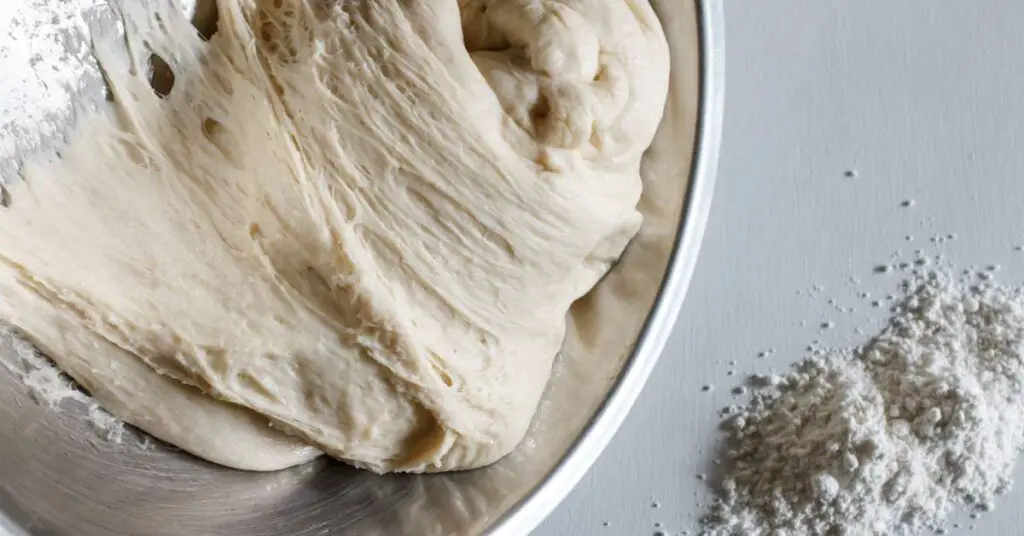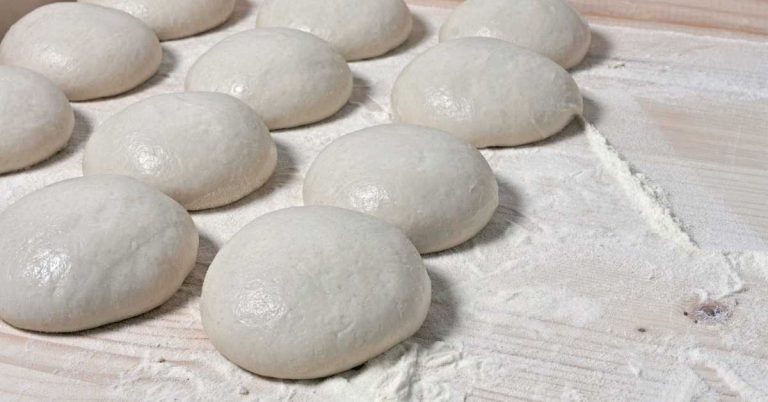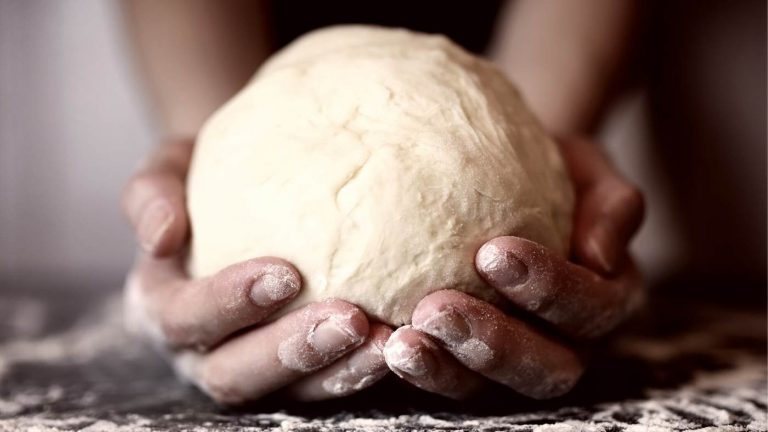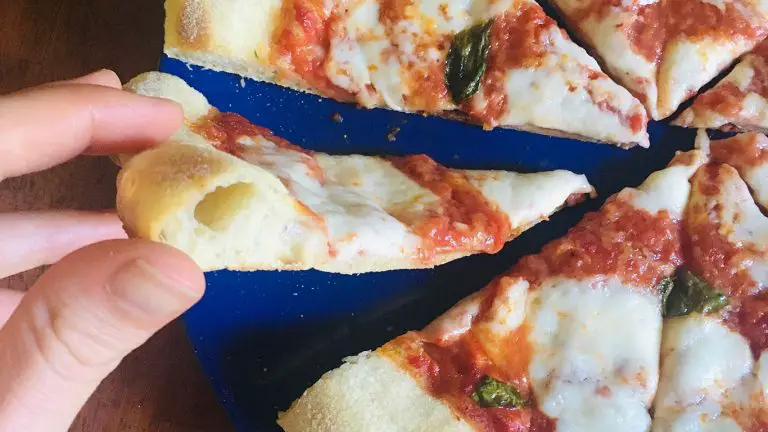Pizza Dough Calculator With Poolish: A Complete Pizza Calculator
This pizza dough calculator takes into account the number and type of pizzas you want to make, the temperature of your oven, and the hydration level. You can even factor in poolish, if you want to.
If you need help figuring out how much dough to make depending on how many pizzas you’re having, you can check out this dough ball size calculator here. Then, you can come back to this one and get the full recipe.

Pizza Dough Calculator With Poolish
Pizza Dough Ingredients:
Flour:
Water:
Salt:
Olive oil:
Honey:
Yeast:
How to use this calculator: getting the right number & type of doughball
Dough Amount: The total weight of the dough you want to produce. For reference, a typical 12 inch pizza is 250-350 grams (9-12 oz), while a typical 16 inch pizza is about 500 grams (19.5 oz). The default value of 500 grams will yield two 250 gram dough balls, perfect for Neapolitan style pizza. If you like your pizza a bit bigger or smaller, feel free to adjust the amounts.
Hydration Level: The ratio of water to flour, expressed as a percentage. A greater amount of water increases this percentage and produces a wetter dough. I recommend using at least 70% if cooking in a home oven because it preserves more moisture during the longer cooking period and doesn’t allow the crust to completely dry out. This calculator has a default hydration level of 70%.
Fermentation Period: The amount of time you plan to let the dough ferment before baking. Basically, how soon do you plan on actually making pizza. Keep in mind that anything less than 12-16 hours will require kneading, or a dough mixer, in order to build the gluten quickly, otherwise you can use the no-knead method. The longer the fermentation period, the better the taste and texture of the baked crust.
Use Poolish: Check this box if you want to create a pre-ferment (known as a poolish) to add flavor and strength to your dough. Only use this option if you know what poolish is and how to use it. If you’d like to learn more about my poolish method, you can consult my poolish pizza dough guide linked below.
Why this pizza dough calculator is different
What separates this calculator from many others is the option to use poolish, as well as the ability to set a custom hydration rate. These factors will help you get exactly the type of doughball you’re aiming for every time.
Poolish is a kind of pre-ferment, which you can learn more about below. Preferments are easy to use, and are a great way to immediately improve the taste and texture of your dough. However, the math required in figuring out what percentage of your ingredients should go in the poolish can be overwhelming, causing many people to just give up. This calculator does all the work for you automatically.
Hydration is key when it comes to making pizza in a home oven, so unless you own a pizza oven, you’ll want to keep it at 70% or higher, in my opinion. Homemade pizza requires the extra water in the dough in order to stay moist during a longer baking period at a (generally) lower.
How to read this calculator if you don’t use metric
I understand that many of you don’t use metric measurements. First of all, I strongly encourage you to invest in a kitchen scale and start using metric weight measurements rather than imperial volumetric measurements (like cups and spoons). It’s easier, and much more accurate. It’ll also open up for you so many high quality recipes online that are metric only.
But for those who can’t, or won’t, use metric. I’ve included standard American measurements next to the metric results. For the sake of accuracy, I’ve left the results decimalized, but you can easily convert them to standard fractions using the reference chart below.
| Decimal | Fraction |
|---|---|
| 0.125 | 1/8 |
| 0.25 | 1/4 |
| 0.333 | 1/3 |
| 0.5 | 1/2 |
| 0.666 | 2/3 |
| 0.75 | 3/4 |
| 1 | 1 |
So, for example, if the calculator calls for 0.14 teaspoons or yeast, the chart above tells us that ⅛ of a teaspoon is close enough. Likewise, if the recipe calls for 3.82 cups of flour, you’ll know based on the chart that that’s about equal to 3 and ¾ cups.
That said, I still recommend just using a kitchen scale rather than dealing with cups, spoons, ounces, grams, etc. A decent kitchen scale is less than 20$ on Amazon, so it’s worth the investment.
Why so much salt?
This is a great question.
An average pizza dough usually has anywhere from 1.5-3% salt (relative to the amount of flour), while this particular pizza dough has 3%—so it’s still within the normal range. The reason we’re using the upper end of the range is because of the fermentation period that this recipe follows. This is also why Neapolitan pizza and dough typically contains around 3% salt as well.
Salt has a moderating effect on yeast, which is very important during long fermentation periods. This prevents the yeast from growing out of control and ruining the taste and texture of your dough. This is why it’s crucial to factor dough yeast content correctly when making pizza dough, especially when fermenting one at room temperature.
If you choose a short fermentation period of just a few hours or less, you can reduce the amount of salt by up to half if you choose. Keep in mind that salt is also a flavor enhancer, so you might find your pizza a little bland tasting if you use too little salt.
Why so little yeast?
This is another great question.
Most recipes you’ll find for pizza dough use way too much yeast, and that negatively impacts the results. Using a full packet of yeast (which is usually around 5 grams) is only appropriate if you plan on using the dough within a few hours of preparing it—and even then, the taste and texture of the dough will suffer.
This is why I always recommend using a small amount of yeast and letting the dough rise slowly over the course of 16-24 hours before using it. This allows for a healthy fermentation period that gradually develops the taste and texture of the dough to be more like a delicious pizza crust and less like a yeasty piece of white bread.
I can promise you that your favorite pizzeria ferments (or proofs) their dough for at least 12-24 hours with a relatively small amount of yeast before serving it to you. Using preferments like poolish and biga is another way to use a small amount of yeast for a better taste and texture.
Useful tools you might want (or need)
To make pizza dough, you don’t need anything besides a mixing bowl and ingredients, but there are a couple of tools that can make your life easier.
A good kitchen scale is crucial for getting consistent results, especially when preparing a dough such as this. You can find a basic digital kitchen scale on Amazon for less than $20, just make sure it can measure weights at least 0.01 grams, which is essential for small quantity ingredients like yeast.
- I have this basic digital kitchen scale at home and it works great, although the weights can sometimes fluctuate by small amounts. It still gets the job done just fine.
- If you want something a little more accurate and suited for making pizza dough, I recommend the Ooni Dual Platform Digital Scale. This scale has two weighing platforms, one for large ingredients and another for small ones. This is great when you have a large bowl of flour and water on one platform, while the smaller more precise platform is free to measure things like yeast and salt.
A Poolish Pizza Calculator
If you select the poolish option, you’ll create a preferment by mixing a portion of the flour, water, and honey, and all of the yeast. This preferment helps develop complex flavors and enhances the texture and structure of the final dough.
You can think of poolish as being similar to a sourdough pizza, except poolish is commercial yeast based while sourdough uses wild yeast.
When making the dough, you’ll combine the poolish with the remaining ingredients which creates the final fresh raw pizza dough you’ll actually use to make pizza.
Here are the basic steps for using poolish in your pizza dough:
- Prepare the poolish by mixing a portion of the flour, water, and all of the yeast.
- Allow the poolish to ferment for a specified period, typically overnight or up to 24 hours.
- Combine the poolish with the remaining ingredients like flour, water, salt, olive oil, and honey to make the final dough mixture.
- Knead the dough thoroughly to develop gluten and distribute the poolish evenly.
- Allow the dough to ferment for the desired period to develop flavor and texture.
- Shape, top, and bake your pizza according to your recipe.
- Remember, there are many ways to use poolish in pizza dough. If you need more assistance and want to see the full process of how I use my poolish, you can consult my poolish pizza dough guide.
From raw ingredients to fresh pizzas at any temperature
The beauty of this calculator is its versatility. Whether you’re a beginner experimenting with a yeast-based dough or a seasoned pro looking to try out a new sourdough pizza or the poolish method, this calculator has you covered. This custom ingredients calculator takes all the guesswork out of the process.
Dough, not just pizza dough
While this calculator was designed primarily as a kind of Neapolitan poolish pizza dough calculator, it can be used to make any other kind of yeast-based dough as well. Tweak some of the ingredients, like the olive oil and salt, and this can easily be used as a bread dough calculator.
How Many Pizzas Does 2 Cups Of Flour Make?
Two cups of flour is approximately 250 grams, which will make you two approximately 10 inch pizzas assuming, a 70% hydration rate. If you increase the hydration rate to 85%, you can make two 12 inch pizzas. Play around with the values in the calculator to match the ingredients you have on hand.
How Much Pizza Dough Per Person?
For a traditional crust pizza, 250-350 grams (9-12 oz) is just the right amount of dough for a personal sized 12 inch pizza. So, for example,1kg of pizza dough makes about four 12 inch pizzas, which is enough food to feed about four people.
How many pizzas can you make with 1lb of dough?
One pound (1lb) of dough is approximately 450 grams, which will give you just enough dough to make two small pizzas, or one large pizza. Of course, this depends on the style of pizza you’re making and the thickness of your crust. I’m assuming a traditional thin crust pizza for this example.
What size pizza do I need for 16 oz of dough?
If you’re making a single pizza with 16oz of dough (450 grams), it will need to be quite large (16-18 inches) unless you’re making a thick crust or pan pizza. Generally speaking, a 12 inch thin crust pizza is between 250-300 grams (9 oz), so 16 oz is more in line with what you’d need for a standard sized Detroit (or Sicilian) style pan pizza with a thick crust.






